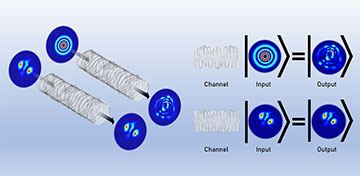
Light gets distorted when passing through a noisy channel such as the atmosphere. Some complex forms of light, however, come out distortion-free, so that the output pattern is the same as the input. [Image: University of the Witwatersrand]
Turbulence in a transmission medium causes both amplitude and phase distortions in structured light, and physicists have developed various correction techniques to repair the damage. But forms of structured light that don’t lose their carefully designed shapes in the first place would be preferable.
Scientists at a South African university have demonstrated that certain forms of structured light that pass through a turbid transmission channel will retain their phase and amplitude (Adv. Photon., doi: 10.1117/1.AP.5.1.016006). The researchers call these structured-light states “the true eigenmodes of atmospheric turbulence” and tested their invariance both theoretically and experimentally.
Although the team studied these structured-light forms in open air, the researchers believe that their results could be extended to long paths in other forms of transmission media: underwater currents, optical fibers or even biological tissue.
The need to eliminate distortion
Structured light—electromagnetic signals tailored in all degrees of freedom—holds great promise in applications ranging from super-resolution microscopy to quantum computing. For example, researchers have used light waves carrying orbital angular momentum extensively in designing optical communication systems. However, attempts to rid signals of the distortion caused by open-air turbulence have been inconclusive.
Most common forms of light become distorted when propagating through free space due to the effects of atmospheric turbulence, as shown at the top. However, an eigenmode of atmospheric turbulence will remain unchanged while passing through the distorted medium, as shown at the bottom. [Image: University of the Witwatersrand] [Enlarge image]
Optica Fellow Andrew Forbes and his colleagues at the University of the Witwatersrand realized that the turbulence in a transmission channel could be treated as a mathematical operator on a beam of light—and that they could calculate the shape of a beam that would be invariant to that operator. In other words, the beam would be an eigenmode of the turbulence.
Tomographic numerical simulations
After working out the mathematics, Forbes and his team performed tomographic numerical simulations of structured-light transmissions over long, turbulent free-space paths. Since atmospheric turbulence typically changes over millisecond time scales while light takes only nanoseconds to travel a few kilometers, the distortions of the medium appear frozen to the structured light.
To test the invariance of the light, the group sent a 633-nm-wavelength He-Ne laser beam through collimating lenses, a spatial light modulator and phase masks that simulated weak, moderate and strong turbulence.
“What is exciting about the work is that it opens up a new approach to studying complex light in complex systems,” Forbes said in a press release, “for instance, in transporting classical and quantum light through optical fiber, underwater channels, living tissue and other highly aberrated systems.”

